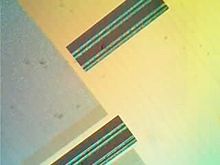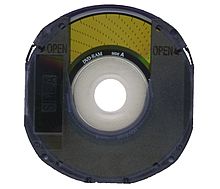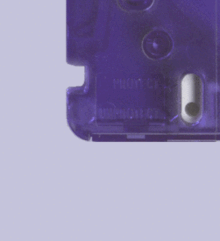- DVD-RAM
-
Optical discs Optical media types - Blu-ray Disc (BD): BD-R, BD-RE
- DVD: DVD-R, DVD+R, DVD-R DL, DVD+R DL, DVD-R DS, DVD+R DS, DVD-RW, DVD+RW, DVD-RAM, DVD-D, DVD-A, HVD, EcoDisc
- Compact Disc (CD): Red Book, CD-ROM, CD-R, CD-RW, 5.1 Music Disc, SACD, Photo CD, CD Video (CDV), Video CD (VCD), SVCD, CD+G, CD-Text, CD-ROM XA, CD-i
- Universal Media Disc (UMD)
- Enhanced Versatile Disc (EVD)
- Forward Versatile Disc (FVD)
- Holographic Versatile Disc (HVD)
- China Blue High-definition Disc (CBHD)
- HD DVD: HD DVD-R, HD DVD-RW, HD DVD-RAM
- High definition Versatile Multilayer Disc (HD VMD)
- VCDHD
- GD-ROM
- MiniDisc (MD) (Hi-MD)
- Laserdisc (LD) (LD-ROM)
- Video Single Disc (VSD)
- Ultra Density Optical (UDO)
- Stacked Volumetric Optical Disk (SVOD)
- Five dimensional disc (5D DVD)
- Nintendo optical disc (NOD)
Standards - SFF ATAPI/MMC
- Mount Rainier (packet writing)
- Mount Fuji (layer jump recording)
- Rainbow Books
- File systems
See also DVD-RAM (DVD–Random Access Memory) is a disc specification presented in 1996 by the DVD Forum, which specifies rewritable DVD-RAM media and the appropriate DVD writers. DVD-RAM media have been used in computers as well as camcorders and personal video recorders since 1998.
Contents
Design
DVD-RAM is one of three competing technologies for rewritable DVDs. Its competitors are DVD-RW and DVD+RW. DVD-RAM technology provides excellent data integrity, data retention and damage protection through a number of mechanisms and properties. Therefore, DVD-RAM is perceived by some people[who?] to be better than the other DVD technologies for traditional computer usage tasks such as general data storage, and especially data backup and archival. The Mount Rainier Format standard and SecurDisc for DVD+/-RW (which also works on DVD-RAM, CD-R, and CD-RW) somewhat lessens the DVD-RAM format's perceived advantage in the data integrity category, but not in the data retention or damage protection categories.
DVD-RAM has a larger presence in camcorders and set-top boxes than in computers[citation needed], although the popularity of DVD-RAM in these devices can be explained by its being very easily written to and erased, which for example allows extensive in-camera editing.
The on-disc structure of DVD-RAM is closely related to hard disk and floppy disk technology, as it stores data in concentric tracks. DVD-RAMs can be accessed just like a hard or floppy disk and usually without any special software. DVD-RWs and DVD+RWs, on the other hand, store data in one long spiral track and require special packet reading/writing software to read and write data discs. Like magneto-optical (MO) technologies, DVD-RAM has numerous rectangles on the disc surface that define the boundaries of data sectors. However, DVD-RAM is not MO but a phase change medium, similar to CD-RW, DVD-RW, or DVD+RW.
Cartridge types
Size Bare disc Non-removable cartridge Removable cartridge Empty cartridge/no disc sides single double single double single double single double 12 cm yes (type 0) none type 1 type 1 type 2 type 4 type 3 type 5 8 cm yes (type 0) none none none type 7 type 6 type 9 type 8 Specification
Since the Internationale Funkausstellung Berlin 2003 the specification is being marketed by the RAM Promotion Group (RAMPRG), built by Hitachi, Toshiba, Maxell, LG Electronics, Matsushita/Panasonic, Samsung, Lite-On and Teac. The specification distinguishes between:
- DVD-RAM version 1.0, recording speed 1x
- * Single-sided, one layer discs with a capacity of 2.58 GB
- * Double-sided one layer discs with a capacity of 5.16 GB
- DVD-RAM version 2.0, recording speed 2x
- * Single-sided, one layer discs with a capacity of 4.7 GB
- * Double-sided one layer discs with a capacity of 9.4 GB
- DVD-RAM version 2.1/Revision 1.0, recording speed 3x
- DVD-RAM version 2.2/Revision 2.0, recording speed 5x
- DVD-RAM version 2.3/Revision 3.0, recording speed 6x max
- DVD-RAM version 2.4/Revision 4.0, recording speed 8x max
- DVD-RAM version 2.5/Revision 5.0, recording speed 12x max
- DVD-RAM version 2.6/Revision 6.0, recording speed 16x max
Physically smaller, 80 mm in diameter, DVD-RAM discs also exist with a capacity of 1.46 GB for a single-sided disc and 2.8 GB for a double-sided disk, but they are uncommon. DVD-RAMs were originally solely sold in cartridges; recent DVD recorders can work with discs either with or without cartridge, and many devices do not support cartridges at all. Discs can be removed from cartridges for use with these drives.
Compatibility
Many operating systems like Mac OS (Mac OS 8.6 up to Mac OS X), Linux and Microsoft Windows XP support DVD-RAM operation directly, while earlier versions of Windows require device drivers or the program InCD.
Windows XP Home and Professional can only write directly to FAT32 formatted DVD-RAM discs. For UDF formatted discs, which are considered faster, a 3rd party UDF file system driver capable of writing or software such as InCD or DLA are required. Windows Vista and later can natively access and write to both FAT32 and UDF formatted DVD-RAM discs using mastered burning method or packet writing. Even though it is possible to use any file system one likes, very few perform well on DVD-RAM. This is because some file systems frequently overwrite data on the disc and the table of contents is contained at the start of the disc.
Mac OS up to 9.2 (Mac OS Classic) can read and write HFS, HFS+, FAT, and UDF formatted DVD-RAM discs directly. Mac OS X officially supports DVD-RAM formatting and writing operations.[1]
Many DVD standalone players and recorders do not support DVD-RAM. However, within "RAMPRG" (the DVD-RAM Promotion Group) there are a number of well-known manufacturers of standalone players, recorders, and camcorders that do support DVD-RAM. Panasonic, for instance, has a range of players and recorders which make full use of the advantages of DVD-RAM.
Some DVD players with hardware DVD-RAM capability are sold without DVD-RAM support. As a specific example, Dell uses the TS-L632D drive manufactured by TSST in some of its laptop computers without DVD-RAM capability. However it is possible, with some difficulty, to replace the firmware with a non-Dell version which supports DVD-RAM.[2]
The newest DVD-RAM Specification, DVD-RAM2 (also called RAM2), is not compatible with DVD drives that do not specifically support reading DVD-RAM2 discs.[3]
Some high end products such as IBM's P-series frames require DVD-RAM instead of DVD-RW.[4]
Advantages
A DVD-RAM for DVD recorders
- Long life — without physical damage, data is retained for an estimated 30 years. For this reason, it is used for archival storage of data.[5][6]
- Can be rewritten over 100,000 times for the lowest write speed discs (DVD±RW can be rewritten approx. 1,000 times). Faster DVD-RAMs support fewer rewrites (3x speed: 100,000, 5x speed: 10,000)[citation needed], but still more than DVD+RW or DVD-RW. (These are theoretical numbers. In practice they could be smaller depending on the drive, the treatment of the disc and the file system.)
- Reliable writing of discs. Verification done in hardware by the drive, so post-write verification by software is unnecessary. Software verification is disabled in all current DVD Video Recorders.
- Disc defect management designed to safeguard data.
- DVD-burning software may not be required — discs can be used and accessed like a removable hard disk. Mac OS (8.6 or later) supports DVD-RAM directly. Windows XP supports DVD-RAM directly for FAT32-formatted discs only. Windows Vista is able to write directly to both FAT32- and UDF-formatted DVD-RAM discs from within Windows Explorer. Device drivers or other software are needed for earlier versions of Windows.
- Very fast access of small files on the disc.
- Small 2 KB disc block size wastes less space when writing small files.
- Finalization not necessary. This is an attribute of the VR recording mode and is available on other media such as DVD-RW.
- Media available with or without protective cartridges; can be used in the cartridge by many devices.
- In some video recorders DVD-RAM can be written to and read at the same time, allowing one program to be recorded and a different one, or an earlier part of the same one (time slip recording), to be viewed at the same time. This is an attribute of the VR recording mode and is possible, although only at lower bit rates, on other media such as DVD+RW.
- Supported by some high-end security digital video recorders, such as the Tecton Darlex, as a secure and long-lasting export medium.
- Holds more data when using Double Sided discs than dual-layer DVD+RW and DVD-RW - 9.4GB for DVD-RAM vs 8.5GB for DVD+RW DL and DVD-RW DL.
- Has write-protect tabs to prevent accidental deletion when used in a cartridge.
Disadvantages
- Media unavailability: Lower popularity of the format makes blank media harder to find at stores.
- High-speed media unavailability: 12x media is not available in the USA, nor Europe, even though 12x drives are readily available, and 16x media may not be available anywhere except manufacturers' R&D laboratories.
- Higher media cost.
- A hazard exists with 16x RAM2 discs in non-RAM2 drives: the disc may be ejected while spinning. Either way it is not a problem of DVD-RAM media, but the drives that do not recognize them properly.
- Less compatibility than DVD+RW and DVD-RW, despite predating both formats (as noted above).
See also
References
- ^ "Using DVD-RAM discs". Docs.info.apple.com. 2004-03-02. http://docs.info.apple.com/article.html?artnum=60235. Retrieved 2009-09-28.
- ^ "RQ TSST TS-L632D 04 DVD-RAM flash — Page 2 - Notebook Forums and Laptop Discussion". Forum.notebookreview.com. http://forum.notebookreview.com/showthread.php?s=668f15eb2b95fc6657bd0f598095ba5c&t=120820&page=2. Retrieved 2009-09-28.
- ^ "Usage Of 16 X DVD-RAM Disc (RAM2 Disc)". Web.archive.org. 2008-01-31. Archived from the original on 2008-01-31. http://web.archive.org/web/20080131133310/http://www.fujitsu.com/ph/services/computing/pc/support/drivers/usage_dvdram.html. Retrieved 2009-09-28.
- ^ "HMC backup". Web.archive.org. Archived from the original on 2007-02-23. http://web.archive.org/web/20070223195406/http://www.pseriestech.org/forum/hardware-management-console/hmc-backup-382.html. Retrieved 2009-09-28.
- ^ "Fujifilm DVD-RAM Disc". Fujifilm. 2006-10-17. Archived from the original on 2006-10-17. http://web.archive.org/web/20061017122044/http://www.fujifilmusa.com/JSP/fuji/epartners/conAVProductsDVD-RAM_Disc.jsp. Retrieved 2009-08-15.
- ^ "Update: Phase Change WORM". West World Productions and Gale Group. http://www.thefreelibrary.com/Update:+Phase+Change+WORM-a060300934. Retrieved 2007-12-29.
External links
Categories:- Optical disc authoring
- Audio storage
- Video storage
- DVD
Wikimedia Foundation. 2010.






